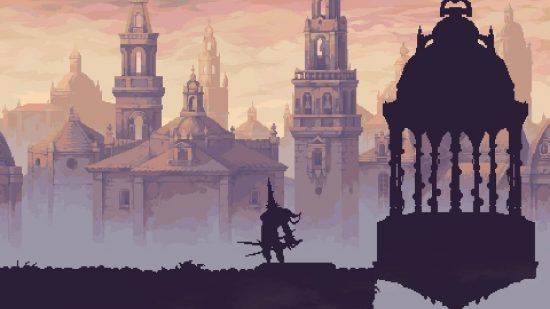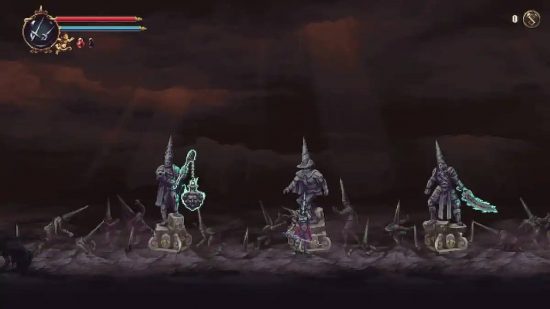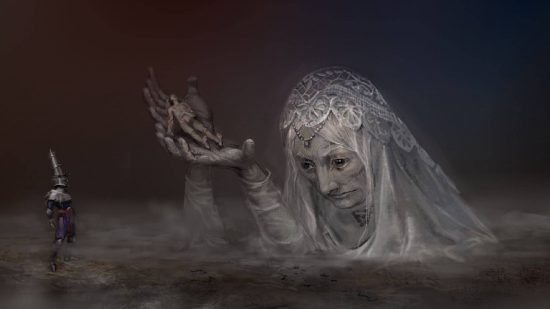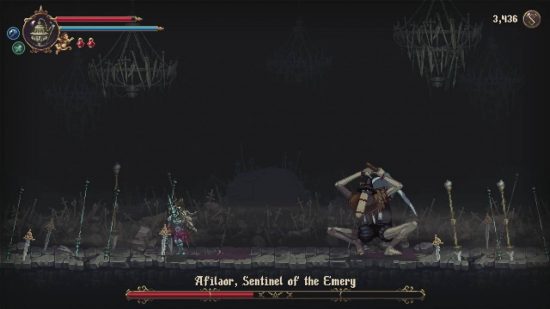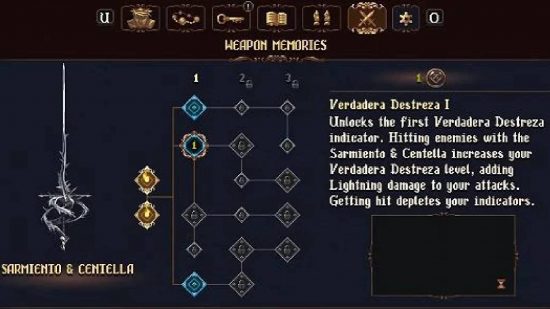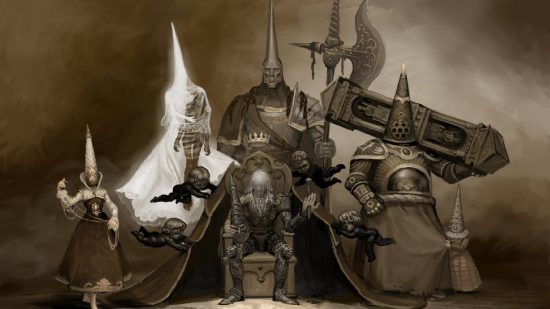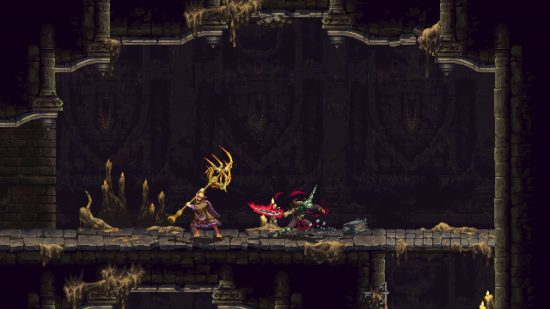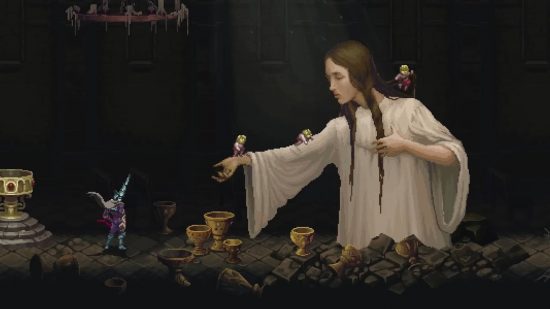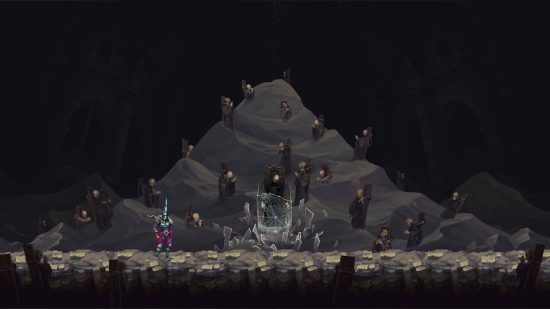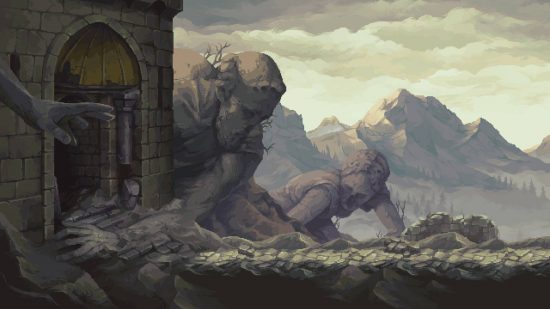We’re in something of a Metroidvania resurgence, to put it lightly. Thanks to the huge efforts of multiple indie developers, the Nintendo Switch and plenty of other consoles contain stellar action platforming games like Hollow Knight, Axiom Verge, and Guacamelee. One such title is the gothic horror action game Blasphemous, and this year developer The Game Kitchen released Blasphemous II.
The Game Kitchen works in Seville, Spain, and the country’s architecture and Catholic culture inform much of the religious imagery and looming decayed cathedrals that give the Blasphemous series its signature look. Alongside this, The Game Kitchen evokes an unsettling and often horrifying level of body horror, with beings twisted and churning in disgusting ways. Blasphemous and Blasphemous II are tough games, and the oppressive world works perfectly to accentuate combat.
You can read all about our love for the latest entry in our Blasphemous II review, and now as the dust settles on its release and The Game Kitchen works away on updates and fixes, we spoke with the games’s Art and Creative Director, Enrique Cabeza, Lead Game Designer, Maikel Ortega, and Lead Level Designer Enrique Colinet, about the sequel. From improvements, different influences, and listening to fan feedback, The Game Kitchen is happy to talk about what is clearly a game born of passion and immense hard work.
Developer The Game Kitchen and publisher Team17 released the original Blasphemous in 2019, and a fanbase quickly developed. The challenging combat certainly has a learning curve, and vocal fans often celebrate the incredible pixelated art, the Souls-like elements, and the rich lore buried in the depths of Cvstodia. Following up on this entry was a challenge, and The Game Kitchen noted a lot of player issues when developing the sequel.
On the topic, Cabeza comments “Community feedback is very important to us, and for the development of Blasphemous 2 we wanted to make sure we were taking the improvement of basic aspects such as character control very seriously.” No game is perfect, and many players noted that movement was one of the original Blasphemous’ weaker elements. He reiterates that the team pushed for the sequel to “feel better, to be more fair, more enjoyable, more precise, and fundamentally, more fun.”
A major change in Blasphemous II is the introduction of three new weapon types. You can choose one from the outset and later uncover the others, unlocking new combat and traversal methods along the way. This comes from feedback within The Game Kitchen, as Cabeza notes the team wanted to “expand the possibilities of combat.” While the Mea Culpa can pack a punch, the team added much more to the action in Blasphemous II as he mentions they thought the original’s combat was “somewhat limited.”
The identity of Blasphemous is deeply intertwined with the developer’s relationship with Catholicism, as well as their home country of Spain. While the sequel brings in new elements, Cabeza tells us that managing to “maintain the identity” of the original game, as well as its cultural influences, but also trying not to “limit our sources of inspiration” was a “difficult process.” As you dive back into Cvstodia with Blasphemous II, it’s refreshing to see a wider net of Spanish influence that works alongside those core values.
Speaking on the newer cultural touchpoints, Cabeza mentions that players can find “references to Spanish cinema, theatre, music, and literature.” They also mention the difficulty in trying to include “these diverse references” while making sure the game still feels “cohesive and natural” as a whole. He continues, saying “It was a long process, but we worked with honesty and passion to find what we were looking for.” The world of Blasphemous II feels richer, and more colorful while plumbing further depths of horror. The team’s work helps to enrich the experience and make our return to this grim world one still full of discovery.
Luckily, the entire development team seems to have been eager to bring in new influences, and Cabeza mentions that as development progressed, different team’s ideas all informed each other. This type of collaboration, he continues, is a “slow cooking process” as “little by little each department is influenced by the other.” He tells us that “artistic ideas for a scenario influence the ideas for level design, and in the end, those ideas end up influencing the design of enemies, other artistic elements, and so a cycle of continuous iteration is born.” Clearly, the team works closely together, and Blasphemous II feels like a game with a tight focus and a clear vision.
When exploring Blasphemous II the world feels more interconnected than its predecessor, and much more like a true Metroidvania. Talking about the design philosophy, Cabeza says “We believe that level design through iteration works well by itself and is the best way for the level design to find its own identity.” He continues, mentioning that the world of Blasphemous is “very art and narrative-driven”, but that level design must go “hand-in-hand” with these aspects. According to Cabeza, “It is a limitation and a great challenge, but at the same time these aspects help give the world design a great personality and help players feel more immersed in the world.”
Of course, a chance to make a sequel means an opportunity to improve things and challenge yourself. Lead Game Designer Maikel Ortega explains to us that when it comes to boss designs, he “love[s] trying new things”. We asked what challenges The Game Kitchen set itself when approaching the sequel, and he told us “There were several challenges I set for myself, like creating a dual boss fight, an elevator fight, a fencing duel…”
Well, Ortega definitely managed to tackle those challenges with aplomb. If you want to learn more, you can also find a fascinating and detailed breakdown of boss animations thanks to Blasphemous II 2D animator Oscar Mardones Ruiz on Twitter.
However, creation is a never-ending process, and he continues by saying that even though the new bosses of Blasphemous II are a dazzling selection of tough foes, “You never feel like a boss fight is finished, you could always polish more, improve it further. So, I don’t know if I achieved it, but it was really fun to work on those ideas.”
With so much expansion of the combat, Ortega also mentions that the “greatest challenge” came with designing the three new weapons. The team wanted to “keep some of the Mea Culpa’s features in each of them” while also managing to create three different weapons and move sets that felt “different and interesting”. This is all in tandem with each weapon’s changes to traversal, and according to Ortega, “Making that work in a Metroidvania was a really difficult and interesting problem to tackle.”
We couldn’t help but ask if the team left any ideas on the cutting room floor, perhaps for a sequel or future content. But when talking about concepts that perhaps didn’t make the cut this time, Ortega tells us “There always are, that’s just the nature of development. But you never know what will happen. We even included enemies and bosses that didn’t make the cut for the first game.”
One of our favorite elements of Blasphemous II is the increasingly interconnected world, with shortcuts and hidden paths twisting back on themselves, making return journeys easier and adding a level of coherence to the land of Cvstodia. We asked the Lead Level Designer Enrique Colinet if this was a design choice from the beginning, to which he answered an empathic “Definitely!” Apparently The Game Kitchen “fully embraced the pure Metroidvania approach for the sequel” and worked hard to meet expectations of the genre while creating a game that is still “doing something unique in the genre.”
Colinet mentions that the team’s focus on the three new weapons, and their accompanying changes to platforming, all make the exploration “completely different from its predecessor”. Wandering the world of Blasphemous II, the improvements are refreshing and exciting. He says that during development “our focus was on making a fun map that you could backtrack too many times with different tools and turning that backtracking into something that always felt pleasant and rewarding, which was one of the most criticized aspects of the first game when it came out.”
The Game Kitchen also mentions that the three new weapon types helped to change the team’s approach to bosses, and enemy attack patterns. Ortega explains that all three weapons “have different strengths and weaknesses” so the team ensured that each weapon felt “fun to use against every boss”. No small task by any means. It also meant that the team couldn’t focus on any one specific weapon function like the parry.
Ortega explains in-depth, saying “Only two out of the three weapons can parry, Veredicto will instead Ignite. It’s also a slower weapon compared to the other two. So, we had to design fights with that in mind, so players that chose Veredicto were able to avoid attacks and find chances for counterattack using the weapon’s unique characteristics (like air-strafing while attacking, or the increased stagger potential).” Compared to Veredicto, faster weapons seem safer, but as Ortega details, while attacks can be “easily canceled into a dodge or a parry” you still need to play more dangerously, in the hopes of dealing more damage.
Meanwhile, Ortega says that bosses needed to become “more aggressive” and use attacks that “directly target the player” in the hopes of balancing out the increase in ranged attacks and prayers. Plus, he adds that the team “added different kinds of fights” all to ensure that “each weapon had its chance to shine”. With some big slow bosses, aerial fights, and some duels, he mentions the huge expansion of scope meant that he and The Game Kitchen “had to change our mindset completely”.
While there are many similarities in tone and combat with titles like Dark Souls, one of the Blasphemous series’ best strengths is a similar approach to lore. Information is hiding, waiting for the curious, and some revelations waiting to reward the players paying attention in the deepest and darkest depths. Discussing this, Cabeza mentions that something really important to the team is that “the game leaves enough room for the imagination, we don’t want to overwhelm players with information that may not be relevant.”
He continues by saying that according to The Game Kitchen, “too many games nowadays saturate players with constant dialogue and information for every little thing” and that they wanted to take a “totally different path.” Alongside the expanded influences, the world feels quite naturally expanded in both scope and narrative, as there’s so much lore that you can discover, both answering and expanding upon mysteries from the original title. In Blasphemous II, Cabeza comments “If you’re the type of player who wants a bit more information the game will eventually provide it to you if you know where and how to look.”
It all sounds quite overwhelming, and so we asked the team just how they kept everything balanced during development. To answer our question, Ortega explains that the key was making sure to balance the “enemies damage’ resistances”. He explains that “enemies in Blasphemous 2 react differently to each weapon and prayer, as there are different damage types in the game.” The Game Kitchen worked hard to “tweak each individual attack stagger and stun values” to ensure that slower weapons still feel powerful, and could interrupt enemy attacks and give the player more chances in combat.
While this was clearly a momentous challenge, Ortega mentions that the greatest challenge was the mission to “balance health values” as the exploration the game offers means that players can reach areas before the game intends, causing a problem when the team wanted to balance the “different damage potentials.” He explains that “the secret is that there is no secret, other than playing the game constantly, taking notes, and updating our balancing charts accordingly.”
With so many different variations of weapons and prayers, The Game Kitchen team often found favorite and interesting new load-outs during development. As Ortega explains “My teammates surprised me with really creative builds that I didn’t think of at all, like one that spawned multiple effects on hit and made the player a counterattack killing machine.”
He tells us “I really like playing with Veredicto’s Deflagration resonance” as the weapon is “satisfying and powerful” and he also loves “air combos igniting the war censer in mid-air.” Adding that “Sarmiento & Centella lightning builds are also a lot of fun, and you can use the Second Wind resonance to ensure your attacks are always powered up!” The scope of these possible weapon combinations is huge and makes exploring the game and even replaying it a blast.
Suitably, it feels like The Game Kitchen has thrown every idea and the kitchen sink into Blasphemous II, so when asked if the team would like to expand on anything in the future, Cabeza gives a very diplomatic answer. He comments “Our current focus is working on fixing the problems we’ve received from players through community feedback, so we don’t currently have anything to talk about regarding DLC.” The team is still hard at work polishing the title, so it’s only fair that the staff take all the time they need.
Finally, with the game now in the bag, and the bulk of development finished, we asked The Game Kitchen if they had a proudest achievement from the process. Cabeza tells us “For me, aside from how challenging the art and design of the game has been, I think we’re very proud of how controlling The Penitent One in the game feels.” It’s absolutely an aspect that pays off, as we agree with his follow-up comment that “the game feels addictive just by moving the character through the levels, exploring, jumping, fighting. I think we’re definitely very proud and happy about that aspect of Blasphemous 2.”
Blasphemous II is clearly a huge labor of love, and both fan feedback alongside a passionate and talented development team are behind a sequel that feels iterative and expansive. The Game Kitchen revisits and hones the best parts of the original, and some surprising new elements work brilliantly with the dark tone and commitment to gothic horror. Whether we can expect Blasphemous III, some DLC, or a brand new game, The Game Kitchen’s eye for details and commitment to quality means we’re excited about anything that comes next.

If this exploration of the dark depths of Cvstodia has you pining for some action, be sure to check out our guides covering the best Switch Metroidvanias and the best horror games for Switch and mobile next.
